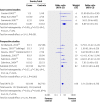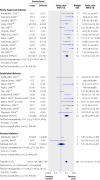Enterovirus infection and type 1 diabetes mellitus: systematic review and meta-analysis of observational molecular studies
- PMID: 21292721
- PMCID: PMC3033438
- DOI: 10.1136/bmj.d35
Enterovirus infection and type 1 diabetes mellitus: systematic review and meta-analysis of observational molecular studies
Abstract
Objective: To review the association between current enterovirus infection diagnosed with molecular testing and development of autoimmunity or type 1 diabetes.
Design: Systematic review and meta-analysis of observational studies, analysed with random effects models.
Data sources: PubMed (until May 2010) and Embase (until May 2010), no language restrictions, studies in humans only; reference lists of identified articles; and contact with authors. Study eligibility criteria Cohort or case-control studies measuring enterovirus RNA or viral protein in blood, stool, or tissue of patients with pre-diabetes and diabetes, with adequate data to calculate an odds ratio and 95% confidence intervals.
Results: The 24 papers and two abstracts (all case-control studies) that met the eligibility criteria included 4448 participants. Study design varied greatly, with a high level of statistical heterogeneity. The two separate outcomes were diabetes related autoimmunity or type 1 diabetes. Meta-analysis showed a significant association between enterovirus infection and type 1 diabetes related autoimmunity (odds ratio 3.7, 95% confidence interval 2.1 to 6.8; heterogeneity χ(2)/df = 1.3) and clinical type 1 diabetes (9.8, 5.5 to 17.4; χ(2)/df = 3.2).
Conclusions: There is a clinically significant association between enterovirus infection, detected with molecular methods, and autoimmunity/type 1 diabetes. Larger prospective studies would be needed to establish a clear temporal relation between enterovirus infection and the development of autoimmunity and type 1 diabetes.
Conflict of interest statement
Competing interests: All authors have completed the Unified Competing Interest form at
Figures
Comment in
-
Enteroviruses and type 1 diabetes.BMJ. 2011 Feb 3;342:c7072. doi: 10.1136/bmj.c7072. BMJ. 2011. PMID: 21292717 No abstract available.
References
-
- Hober D, Sauter P. Pathogenesis of type 1 diabetes mellitus: interplay between enterovirus and host. Nat Rev Endocrinol 2010;6:279-89. - PubMed
-
- Diamond PG. Incidence and trends of childhood type 1 diabetes worldwide 1990-1999. Diabet Med 2006;23:857-66. - PubMed
-
- EURODIAB. Variation and trends in incidence of childhood diabetes in Europe. Lancet 2000;355:873-6. - PubMed
-
- Patterson C, Dahlquist G, Gyürüs E, Green A, Soltész G. Incidence trends for childhood type 1 diabetes in Europe during 1989-2003 and predicted new cases 2005-20: a multicentre prospective registration study. Lancet 2009;373:2027-33. - PubMed
-
- Chong J, Craig M, Cameron F, Clarke C, Rodda C, Donath S, et al. Marked increase in type 1 diabetes mellitus incidence in children aged 0-14 yrs in Victoria, Australia, from 1999 to 2002. Pediatr Diabetes 2007;8:67-73. - PubMed
Publication types
MeSH terms
Substances
LinkOut - more resources
Full Text Sources
Other Literature Sources
Medical
Miscellaneous


